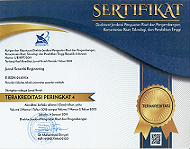Pengaruh Komposisi Bahan Bakar Oli Bekas dan Minyak Goreng Bekas Terhadap Suhu Pembakaran Pada Kompor Bertekanan
Keywords:
Household waste, used oil, used cooking oil, steam pressure stoveAbstract
The management of waste has become a increasingly intricate matter due to the rising volume of household waste. The present study evaluates the effect of the composition of a mixture of used oil and used cooking oil as an alternative fuel on the combustion temperature in a steam pressurized stove. Four distinct variations of fuel composition were meticulously executed: 300:0, 150:150, 50:250, and 0:300. These variations were then subjected to rigorous testing, entailing the measurement of temperature at the steam output chimney section at five-minute intervals for a duration of 40 minutes. The findings indicated that augmenting the quantity of cooking oil in the mixture led to a reduction in combustion temperature. The highest recorded temperature was attained at a composition of 300:0 (pure used oil), reaching 680°C, while the lowest temperature was observed at a composition of 0:300, with a temperature of 275°C. A subsequent analysis of variance (ANOVA) revealed a statistically significant disparity in the average combustion temperatures of the distinct fuel compositions (p-value < 0.05). The composition of the pure used oil, characterized by its high hydrocarbon content and calorific value, yielded a combustion process that was more efficient and stable. In contrast, cooking oil exhibited a lower combustion efficiency. The present study lends support to the utilization of liquid waste as an alternative fuel, a practice that has the dual benefits of reducing waste volume and producing useful by-products, including heat energy and gas.
References
[1] A. W. Agustin, Sudarti dan Yushardi, “Potensi Pemanfaatan Biogas Dari Sampah Organik Sebagai Sumber Energi Terbarukan,” INSOLOGI: Jurnal Sains dan Teknologi, vol. 2, no. 6, pp. 1109-1116, 2023.
[2] A. U. Farahdiba, I. D. A. A. Warmadewanthi, Y. Fransiscus, E. Rosyidah, J. Hermana and a. A. Yuniarto, "The present and proposed sustainable food waste treatment technology in Indonesia: A review," Environ. Technol. Innov., vol. 32, no. 1, p. 103256, 2023.
[3] R. H. Teoh, A. S. Mahajan, S. R. Moharir, N. A. Manaf, S. Shi and a. S. Thangalazhy-Gopakumar, "A review on hydrothermal treatments for solid, liquid and gaseous fuel production from biomass," Energy Nexus, vol. 14, no. Dec 23, p. 100301, 2024.
[4] A. I. Adetunji, P. J. Oberholster and a. M. Erasmus, "From garbage to treasure: A review on biorefinery of organic solid wastes into valuable biobased products," Bioresour. Technol. Reports, vol. 24, no. August, p. 101610, 2023.
[5] H. Kaur, S. Ismail, M. Adnan and a. B. Ranjan, "Chemosphere Coupling hydrothermal liquefaction and anaerobic digestion for waste biomass valorization : A review in context of circular economy," Chemosphere, vol. 361, no. May, p. 142419, 2024.
[6] H. Pasalari, A. Moosavi, M. Kermani, R. Sharifi and a. M. Farzadkia, "A systematic review on garbage enzymes and their applications in environmental processes," Ecotoxicol. Environ. Saf., vol. 277, no. 1, p. 116369, November 2023.
[7] R. Andriani dan H. & Sutrisno, “Pengaruh Minyak Goreng Bekas Terhadap Stabilitas Pembakaran Pada Sistem Pengolahan Limbah,” Jurnal Teknologi Lingkungan, vol. 12, no. 4, pp. 210-218, 2019.
[8] F. Rahman, S. Sudarmono and A. & Anwar, "Pemanfaatan Oli Bekas Sebagai Bahan Bakar Alternatif: Studi Eksperimental Pada Pembakaran Bertekanan," Jurnal Energi Terbarukan, vol. 8, no. 3, pp. 125-132., 2020.
[9] S. E. Derdera and G. S. and Ogato, "Towards integrated, and sustainable municipal solid waste management system in Shashemane city administration, Ethiopia," Heliyon, vol. 9, no. 11, p. 21865, 2023.
[10] A. Widodo dan D. & Sutanto, “Studi Penggunaan Limbah Oli untuk Efisiensi Pembakaran pada Proses Pengolahan Sampah,” Jurnal Energi dan Lingkungan, vol. 10, no. 1, pp. 45-52, 2022.
[11] B. Susanto, T. Nugroho and R. & Ramadhan, "Efektivitas Pembakaran Sampah Menggunakan Kompor Bertekanan Steam.," Jurnal Teknologi Pengolahan, vol. 17, no. 1, pp. 55-63, 2019.
[12] A. Rivai, M. Fausy and Mulyadi, "Penggunaan Alat Pembakaran Sampah Tanpa Asap Untuk Mengatasi Pencemaran Lingkungan," Jurnal Sulolipu : Media Komunikasi Sivitas Akademika dan Masyarakat, vol. 23, no. 1, pp. 45-50, 2023.
[13] A. N. Putri and I. & Anwar, "Optimasi Nilai Kalor Campuran Minyak Goreng Bekas untuk Pembakaran Industri," Jurnal Teknik Energi, vol. 6, no. 2, pp. 101-109, 2018.
[14] R. Kurniawan dan D. & Lestari, “Pendekatan Terpadu Pengelolaan Limbah Perkotaan Berbasis Energi,” Jurnal Sains dan Teknologi, vol. 19, no. 3, pp. 189-198, 2021.
[15] H. Prasetya, A. Wijaya dan R. & Lestari, “Potensi Pemanfaatan Sampah Organik Rumah Tangga untuk Bahan Bakar Alternatif di Indonesia,” Jurnal Pengelolaan Lingkungan, pp. 35-45, 2021.
[16] F. N. Rahmat, Sudarti and Yushardi, "Analisis Pemanfaatan Sampah Organik Menjadi Energi Alternatif Biogas," Jurnal Energi Baru & Terbarukan, vol. 4, no. 2, pp. 118-122, 2023.
[17] W. P. Raharjo, "Pemanfaatan TEA (Three Ethyl Amin) Dalam Proses Penjernihan Oli Bekas Sebagai Bahan Bakar Pada Peleburan Aluminium," Jurnal Penelitian Sains & Teknologi, vol. 8, no. 2, pp. 166-184, 2007.
[18] A. Kusnadi, R. Djafar and Mustofa, "Pemanfaatan Oli Bekas Sebagai Bahan Bakar Alternatif Kompor Yang Ramah Lingkungan," Jurnal Teknologi Pertanian Gorontalo, vol. 5, no. 2, pp. 49-55, November 2020.
Downloads
Published
Issue
Section
License
Copyright (c) 2025 Harita Nurwahyu Chamidy (Author)

This work is licensed under a Creative Commons Attribution 4.0 International License.












